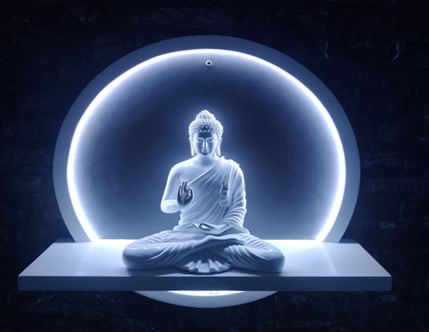Reaching nirvana, or full awakening, is the ultimate goal in Buddhism. At this stage, you’re free of every worldly illusion and suffering and have eliminated greed, hatred, and ignorance from your being. It is also in the state of full spiritual awakening that the enlightened individual escapes the endless cycle of death and rebirth.
This cycle is known as Saṃsāra. Simply put, it is the Buddhist view of the world we live in. It is perpetuated and fueled by Karma, the future consequences of one’s actions. The cycle is seen to be filled with pain and suffering, and it is the goal of every disciple on the path to nirvana to escape it.
What Are The 4 Stages Of Awakening?
According to Theravada and Early Buddhism, two of the oldest Buddhist schools, there are four stages to full awakening. These include:
- Sotāpanna (stream-enterer)
- Sakadāgāmi (once-returner)
- Anāgāmi (non-returner)
- Arahant
These stages are achieved progressively, with the earliest being Sotāpanna, and the Arahant representing a fully awakened person.
- Sotāpanna (stream-enterer)
This is the first stage of spiritual awakening. Sotāpanna means “one who enters the stream,” with the stream being the Noble Eightfold Path. This path is a summary of the Buddhist practices that lead to nirvana and liberation from rebirth. As its name indicates, the path consists of eight practices:
- Right understanding (Samma ditthi)
- Right thought (Samma sankappa)
- Right speech (Samma vaca)
- Right action (Samma kammanta)
- Right livelihood (Samma ajiva)
- Right effort (Samma vayama)
- Right mindfulness (Samma sati)
- Right concentration (Samma samadhi)
The individual realizes that liberation can only be attained by practicing the Noble Eightfold Path. With this realization, they drop their attachment to rites and rituals. This is one of the first three fetters that must be eradicated to become a Sotāpanna.
The fetters are shackles that chain a being to Saṃsāra, the cycle. There are five lower fetters and five higher fetters. To be completely free, one has to eradicate all ten fetters and become an arahant.
The three fetters that the Sotāpanna has dropped on their journey are:
- A view of oneself or clinging to the concept of “I,” “me,” or “mine.”
- An attachment to rites and rituals.
- Doubts about Buddha and his teaching, the Dharma.
Having eradicated the fetters, the individual has opened the eye of the Dharma. This simply means they now understand Buddha’s teachings intuitively and have unshakable faith in the Dharma. An individual who has attained this stage has escaped rebirth as any of the three forms lower than humans; an animal, a hungry ghost, or a being from hell.
- Sakadāgāmi (once-returner)
At this stage, the individual can be regarded as partially enlightened, having discarded the first three lower fetters and significantly reduced the hold of the fourth and fifth. The fourth and the fifth fetters are sensual desire and ill will. In comparison, these are still largely present in the Sotāpanna.
Like the Sotāpanna, the Sakadāgāmi will never be reborn in any of the three realms lower than human. Having moved to the second stage of full awakening, they will also be reborn in the realm of the senses only once. This realm contains beings that range from humans to celestial beings
- Anāgāmi (non-returner)
The Anāgāmi is the non-returner, and as the name indicates, this simply means they won’t be reborn in the human world. They also wouldn’t be reborn in any realm lower than that of humans. Instead, they are reborn in one of the five special worlds in the “Pure Abodes.” The Pure Abodes, or Śuddhāvāsa worlds, are in a plane in Buddhist cosmology that only an Anāgāmi can enter.
The non-returner gains access to this world having abandoned all five lower fetters, including the fetters of sensual desire and ill will that were still present in the Sakadāgāmi. It is in the Pure Abodes that the Anāgāmi will destroy the five higher fetters and attain full awakening as Arahants.
In some cases, instead of reaching Nirvana, the Anāgāmi is reborn sequentially in each of the five heavens in the Pure Abodes. Starting from the lowest, they reach the highest heaven before they can become fully awakened.
- Arahant
This is an individual who has achieved full awakening and destroyed all five lower and five higher fetters. The five higher fetters that the Arahant has fully discarded are:
- Attachment to material existence.
- Attachment to immaterial existence.
- Pride
- Restlessness
- Ignorance
The Arahant will never be reborn in any world, having fully escaped the cycle of death and rebirth.
Your Journey To Full Awakening: Final Thoughts
There are a few Buddhist schools with somewhat different teachings on how to attain full awakening. The one you choose depends on what you decide works best for you. However, note that Theravada Buddhism might be the purest (closest to Buddha’s original teaching) in existence.
It’s important not to link the 4 stages of awakening with any popular chakra system through your own understanding, as the Buddha never directly mentioned chakras in any of his teachings. Acknowledging subtle energies and learning how to harness them is best done with proper spiritual guidance, guru,or teacher.
About the Author
Karen Sarandon is a mindfulness teacher and the proud mother of three beautiful kids. She is also a writer and the founder of Mother’s Guide Online. Passionate about motherhood, she spends her days teaching moms and expectant mothers to meditate and grow their mental strength. You can always find her doing one of three things: meditating, teaching chess to her youngest (Alice), or pouring decades of meditation practice and learning into an article.
